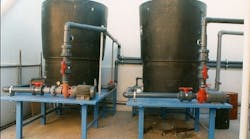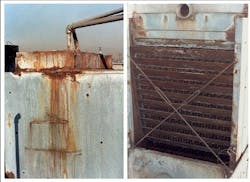Go plastic with your cooling towers and reap the reward of lower corrosion
Engineered plastic cooling towers are transforming the industry, eliminating the problems that plague galvanized metal cooling towers - corrosion, leakage, maintenance costs and process disruptions caused by internal and environmental pH factors.
The "traditional" metal-clad cooling tower is under attack from all sides, particularly in the process industries where they are critical to maintaining temperature ranges for every process that creates heat. Not only are exorbitant maintenance costs and disruptions making those classic zinc-plated models outmoded, but the very laws of nature seem to working against metal cooling towers for a wide variety of industrial applications.
|
View more content on PlantServices.com |
"Metal-clad cooling towers are being eaten alive by harsh environments," says "Jim Ruddy, President of Proprietary Systems, Inc., Westlake Village, California. "They rust and corrode all the time. They are attacked internally by process chemicals and externally by environmental elements. Metal tower technology is antiquated and very expensive to maintain. Metal towers can also corrupt processes, causing headaches that can cost thousands of dollars many times over."
Having come from the metals processing industry, Ruddy received a first-hand education on the disruptions and expenses that can result from problematic metal cooling towers.
"In our business we used big power supplies for heating and melting through induction," Ruddy explains. "Metal cooling towers were plagued by rust and corrosion. Rust would get into the water system and lodge in an SCR (silicon-controlled rectifier) and short it out. Poof - there goes another $2,000 SCR. The maintenance guys sometimes changed SCRs like light bulbs."
The natural and mortal enemy of metal-clad cooling towers is pH, usually on the low side. A high pH leads to excessive calcium and other ceramic-like deposits. When the pH of a liquid coolant becomes acidic (low), either because of external (e.g. atmospheric) elements or infiltration of process elements (e.g. material fines), the veneer of zinc galvanizing used on most metal towers immediately begins to deteriorate. Because the zinc plating is thin (normally a scant 2.5 oz. per sq. ft), a pH lower than 4 will destroy this protective lining in a matter of months. At that point contractors are required to replace the zinc galvanizing by expensive coatings and repair any cavities and other damage that may have occurred. If the repair process is extensive, costly process interruptions may be required.
Ruddy, whose earlier experience led him to the cooling tower business via Proprietary Systems, says pH problems can come from a number sources.
"We have customers who use solvents or de-scalers to prevent scale from occurring in their process fluids," Ruddy says. "These chemicals sometimes leak into the cooling system and they corrode the cooling towers. Sometimes the solvents attack the metal at the seams, other times they just wear down the galvanizing. But either way, once the zinc plating of a metal tower is undermined, you're looking at escalating trouble, possibly including expensive repairs or even replacement"
Reinventing the cooling tower
The inherent susceptibility of metal cooling to high and low pH has led to the development of a new technology that is rapidly replacing the older one, particularly in the process industries: the engineered plastic cooling tower.
Composed of material that is literally impervious to the harsh pH environments that devastate metal cooling towers, engineered plastic cooling towers are energy efficient, available in a wide array of capacities and air flows, and will operate with both process and energy efficiency for many years.
Ruddy's distribution organization, Proprietary Systems, provides engineering consultation as well as the latest designs in corrosion-proof polyethylene-plastic cooling tower technology from Delta Cooling Towers (www.deltacooling.com) of Rockaway NJ.
The first plastic cooling towers became available in limited smaller sizes 30 years ago. The success of those early models gave rise to second, third and now a fourth generation engineered plastic cooling towers that are much larger in capacity, lightweight and seamless. These towers will not rust, chip, flake, peel or require paint or other protective coatings.
"There is simply no way that we would use a metal cooling tower," says Doug Martin, Vice President and Operations Manager at H. J. Baker & Brothers' Wilmington California plant. A leading supplier of prilled sulfur for the agricultural trade, H.J. Baker & Bros. processes over 250,000 tons of sulfur a year at two California facilities
"We spray molten sulfur into cool water in the prilling process," Martin explains. "A cooling tower is needed to chill the process water after the sulfur bath. While the process water is part of a separate system, it becomes somewhat corrupted by minute sulfur fines in it. Those sulfur fines make the cooling system water highly acidic."
Martin says that the sulfuric water would attack any metal surface it contacts. For that reason the plant uses a Delta engineered plastic cooling towers, and was able to get 20 years worth of very aggressive service from the first installed unit. (Today, the standard warranty for a Delta cooling tower is 15 years.) With so many inherent vulnerabilities, metal-lined cooling towers generally carry only a one-year warranty.
Ramcar, a major manufacturer of car batteries, uses an engineered-plastic cooling tower to protect against the ravages of sulfuric acid at its City of Commerce, California plant.
"We use relatively high concentrations of sulfuric acid (25-35%) mixed with the water used in our batteries," explains Larry Eslao, Chief Engineer. "This mixture gets very hot, so we designed our process to run the mixture through a cooling tower. Of course, with such a harsh mixture we would not want to use a metal clad tower, which would have a very short lifespan. We purchased this Delta plastic model because it is impervious to acid. We bought our present tower in 1987; it has proved to be virtually maintenance free."
Cooling towers cool water through heat transfer and evaporation. With a loss of 1% water for every 10 degrees of cooling required, the evaporation factor can be very significant - 20 or 30 gallons per minute is not uncommon for small towers. When evaporation occurs scale is left behind, which can interfere with cooling tower efficiency and require expensive maintenance or acid cleaning. Because plastic cooling towers are impervious to residual salts, it cannot damage the tower and it can be cleaned up by simply washing down the plastic surface with a hose.
"The plastic tower is not affected by pH," says Ruddy. "A high pH is going to result in salts collecting in the tower. You may have to use very aggressive cleaning chemicals to dissolve the salts. In a metal tower that is designed with seams that come down as a right-angle flange, powerful cleaners will penetrate those seams. Then, after cleaning, a base is added to neutralize the acid and bring the pH back up. But the bases don't penetrate, so the acid remains in the seam. So, you have a flange on a metal tower and the acid sits in the seams, working on the thin galvanizing and eroding it."
Ruddy points out that many companies feel they cannot afford frequent cleanings of their cooling towers. So, over time, a sizable amount of dirt may collect in the bottom of the tower sump.
"This is bad news for metal cooling towers," Ruddy says. "There is a difference in the electrical potential between the water on the top and the metal in the tower. So, a small electrostatic charge occurs in the tower and eats through the metal, creating pinhole leaks on the bottom of the metal towers. Once you get a hole in the galvanized tower, it starts to rust out from there - like a cancer that goes in all directions at once."
On the other hand, plastic cooling towers are also ideal for harsh environments. They are impervious to salt air and waste products that can often be found in the air in many industrial areas. They are also impervious to a variety of minerals found in extremely hard water.
"If you get a lot of calcium or other heavy mineral deposits in a plastic cooling tower, it won't cause any damage," Ruddy says. "We have a customer in Bakersfield with extremely hard well water. But they have plastic cooling tower, and even though the mineral deposits get as big as the stalactites of Carlsbad Caverns, they don't do any damage. The plastic material of the tower is flexible enough that you can simply break off the deposits and toss them away."
Utilizing advanced resins and molding techniques, today's engineered plastic cooling towers are available in larger sizes and modular configurations for high-capacity applications (1,500 - 2,000 cooling tons).
Competitive in price, engineered plastic cooling towers are one-piece, so there are no problems with seams, welds, and patches. They are rust and corrosion-proof. The largest cooling towers manufactured by Delta for example, are rotary-cast with a double-wall UV-protective, polyethylene shell that is virtually impervious to weather conditions and harsh environmental elements. Water pH can vary wildly without affecting the resin material. Stress from frequent turning on and shutting off cooling towers is no factor.
For more information, contact Delta Cooling Towers, Inc., 41 Pine Street, Rockaway, NJ 07866; Phone (800) BUY.DELTA (289.3358); Fax 973.586.2243; E-mail: [email protected]; or visit the web site: www.deltacooling.com


